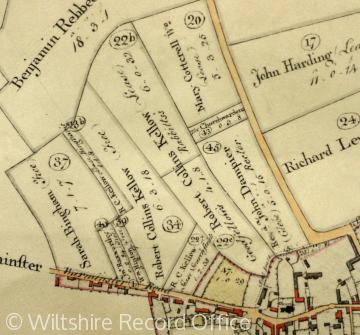Enclosure
 A section of the Inclosure Map for Codford St Peter, 1810
A section of the Inclosure Map for Codford St Peter, 1810The term enclosure really means the ‘closing’ or en-closing of land, in other words the assertion of private property rights over a piece of land which had previously been held in severalty. The land could be held in common fields or in common pastures, but the key point was that these were held in common rather than as private concerns. Landowners and farmers sought to enclose where they perceived an advantage in terms both of output and rent. In the sixteenth century much enclosure was to lay down arable land to permanent grass so that farmers could obtain the higher profits to be made from wool, by grazing sheep rather than mixing arable and pastoral output. At first, especially in the sixteenth and early seventeenth centuries, the government opposed enclosure as being detrimental to the common weal (as it was known) by as the seventeenth century proceeded it shifted towards a more tolerant attitude.
As a result, many local enclosure ‘agreements’ were confirmed through the Westminster courts. From the mid-18th century the government went further, passing privately sponsored legislation to encourage enclosure. Between the mid-18th and mid-19th centuries, around 6 million acres were enclosed by the terms of more than 4000 pieces of legislation. As a result the great majority of land had, by then, been enclosed. The benefits of enclosure were not easy to measure. It was normally argued that enclosed land in ring fenced farms was more efficient and so productivity rose, but that is less easy to measure than the rise in rents, which often doubled or more following the completion of an enclosure. Although it was once argued that enclosure was a massive swindle on the agricultural labouring community and on farmers, because it led to larger estates paying greatly inflated rents to landlords, and the labour force being pushed off the land into urban jobs, it is now thought that this is a romantic rather than an accurate representation of the past. The number of people working the land did not decline significantly through the major period of enclosure, and many farmers were able to adjust their methods to take account of changing practices. On the whole enclosure has been regarded as a good thing for the productivity of English agriculture.

